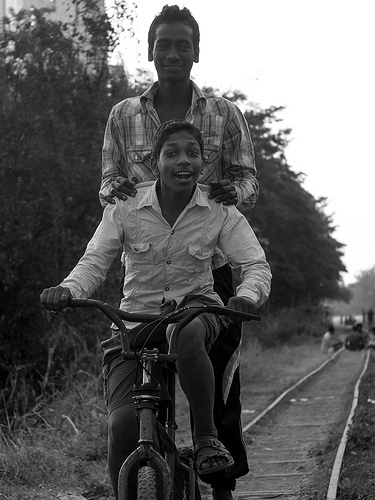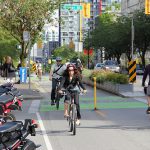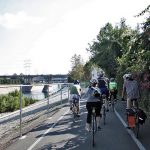How protected bike lanes can combat discrimination

Cyclists in Mumbai. Image from streetwrk.com.
A new report from PeopleForBikes and Alliance for Biking & Walking has yielded some fascinating insights about cycling. “Building Equity: Race, ethnicity, class, and protected bike lanes: An idea book for fairer cities,” focuses on how transportation can be a great equalizer through the use of protected bike lanes. The report draws on the a pool of experts of color including planners, leaders, activists and organizers who are working on building connected bike networks. It attempts to answer the burning questions of how protected bike lanes can make American cities less inequitable, how city staff can implement transportation justice, and how bike infrastructure investments can bolster others in order to help address inequality.
An informative group of case studies-meet-personal stories center on Atlanta, GA, Queens, NY, San Francisco, CA, Seattle, WA, and other urban hubs. Consider Nedra Deadwyler of Atlanta, GA, who runs Civil Bikes, a company offering bike tours that explore the civil rights movement. Her insight into biking’s impact on equality boils down to community: “Calm the cars down, make our sidewalks more interesting. Make the bike lanes more visible,” she says. “We’re learning how to change our bike lanes, how to look at our sidewalks. How to create these community spaces.” Then there’s Nancy Helpern Ibrahim of Los Angeles, CA, who has advocated for access to healthier food for working families by improving bike, foot and transit access to neighborhood markets, and Marven Norman of Inland Empire, CA, substitute teacher and vice president of the Inland Empire Biking Alliance, who advocates for infrastructure in minority communities by attending meetings and spreading the cycling gospel to his low-income students.
Other leaders are working to change the public’s perception of biking. Denver’s Councilman Albus Brooks attended the PeopleForBikes’ Copenhagen study tour of protected bike lanes and it changed his perspective on biking. Brooks had never owned a bike prior to the trip, but purchased one after it, and began riding it to meetings. “I came in in a suit and a bike helmet,” he said of showing up in his gear. “These were all middle-class African-Americans that do not ride bikes. And they looked at me as if I were an alien.” He started planning cultural bike rides on streets with temporarily-blocked car traffic to shift perspective. “The old-school of thinking was, let’s just build around the car,” Brooks said. “I want to build our city around people. Around diverse interests and individuals in our city—not around vehicles.”
But the study provides more than expert insights; it also delves into the impact of biking in non-European cities, which are often used for comparison. The report analyzes how Bogota, Colombia’s distribution of road space among all citizens can help promote equality, and examines Hangzhou, China, where the world’s largest bike sharing system was launched in 2004. PeopleForBikes’ own research into equitable biking is also spotlighted, with details on low-income and minority biking habits and attitudes (check out page 33 for all the details).
Cyclists and advocates alike will appreciate the report’s candor and practicality, rooted in a desire to implement change. As the study authors themselves explain, “Transportation has been near the heart of that struggle [against discrimination] from the start. From housing choice to bus frequency to freeway routing to sidewalk quality, cities have often failed to equitably distribute the costs and benefits of mobility… We all want to make sure the process of lacing green bike lanes across city maps doesn’t repeat the damage that redlining diverse communities once did.”
Related Posts
Category: Infrastructure, Transportation
















